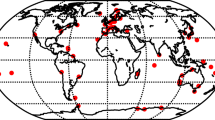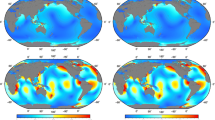Abstract
Earth tide effects play important roles in evolution of the Earth–Moon system. At present, a Five-Time-Delay tide model developed by the JPL ephemeris group is widely adopted in the development of high-precision planetary and lunar ephemerides. However, a significant discrepancy between tide models of Five-Time-Delay type and a conventional model suggested by the International Earth Rotation and Reference Systems Service (IERS2010 model) used in fields of geodesy and geophysics exists. The paper aims to investigate possible causes of the above-mentioned discrepancy and derives an Earth tide model closer to the IERS2010 model. We found that the discrepancy between the IERS2010 model and tide models of Five-Time-Delay type was mainly caused by an error in computation of diurnal tidal parameters in previous tide models of Five-Time-Delay type. After correcting tidal parameters caused by the error, we obtain a new parametrization of Five-Time-Delay model with a weighted least square method. The difference of an updated model and the IERS2010 model can be reduced to the level of less than one-tenth of the IERS2010 model. The discrepancy between models of Five-Time-Delay type and IERS2010 model is dominated by resonance phenomena at diurnal band, and by cross-over terms and retrograde terms induced by dynamical effects of ocean tides at low-frequency and semi-diurnal bands.






Similar content being viewed by others
Data availability
The datasets analyzed during the current study are available in the repository.
References
Cartwright, D.E., Tayler, R.J.: New computations of the tide-generating potential. Geophys. J. R. Astron. Soc. 23(1), 45–73 (1971). https://doi.org/10.1111/j.1365-246X.1971.tb01803.x
Fienga, A., Deram, P., Di Ruscio, A., Viswanathan, V., Camargo, J.I.B., Bernus, L., et al.: INPOP21a planetary ephemerides. Notes Scientifiques et Techniques de l’Institut de Mecanique Celeste 110 (2021)
Folkner, W.M., Williams, J.G., Boggs, D.H., Park, R.S., Kuchynka, P.: The planetary and lunar ephemerides DE430 and DE431. Interplanet. Netw. Prog. Rep. 42–196, 1–81 (2014)
Lambeck, K.: The Earth’s Variable Rotation: Geophysical Causes and Consequences. Cambridge University Press, Cambridge (1980)
Lieske, J.H.: Precession matrix based on IAU (1976) system of astronomical constants. Astron. Astrophys. 73(3), 282–284 (1979)
Lyard, F., Lefevre, F., Letellier, T., Francis, O.: Modelling the global ocean tides: modern insights from fes2004. Ocean Dyn. 56(5), 394–415 (2006). https://doi.org/10.1007/s10236-006-0086-x
Mathews, P.M., Buffett, B.A., Shapiro, I.I.: Love numbers for a rotating spheroidal earth new definitions and numerical values. Geophys. Res. Lett. 22(5), 579–582 (1995). https://doi.org/10.1029/95GL00161
Park, R.S., Folkner, W.M., Williams, J.G., Boggs, D.H.: The JPL planetary and lunar ephemerides DE440 and DE441. Astron. J. 161(3), 105 (2021). https://doi.org/10.3847/1538-3881/abd414
Pavlov, D.A., Williams, J.G., Suvorkin, V.V.: Determining parameters of Moon’s orbital and rotational motion from LLR observations using GRAIL and IERS-recommended models. Celest. Mech. Dyn. Astron. 126(1–3), 61–88 (2016). https://doi.org/10.1007/s10569-016-9712-1
Petit, G., Luzum, B.: IERS conventions (2010). IERS Tech. Note 36, 1 (2010)
Seidelmann, P.K.: 1980 I.A.U. theory of nutation—the final report of the I.A.U. working group on nutation. Celest. Mech. 27(1), 79–106 (1982). https://doi.org/10.1007/BF01228952
Tian, W.: Petrel19: a new numerical solution of planetary and lunar ephemeris. Celest Mech Dyn Astron (in review) (2022)
Urban, S.E., Seidelmann, P.K. (eds.): Explanatory Supplement to the Astronomical Almanac, 3rd edn. University Science Books, Mill Valley (2012)
Williams, J.G., Boggs, D.H.: Secular tidal changes in lunar orbit and Earth rotation. Celest. Mech. Dyn. Astron. 126(1–3), 89–129 (2016). https://doi.org/10.1007/s10569-016-9702-3
Williams, J.G., Sinclair, W.S., Yoder, C.F.: Tidal acceleration of the moon. Geophys. Res. Lett. 5(11), 943–946 (1978). https://doi.org/10.1029/GL005i011p00943
Acknowledgements
The authors are grateful to the referees for the valuable comments that improved the manuscript significantly.
Author information
Authors and Affiliations
Corresponding author
Additional information
Publisher's Note
Springer Nature remains neutral with regard to jurisdictional claims in published maps and institutional affiliations.
Appendix A Derivation of Eq. 2
Appendix A Derivation of Eq. 2
The definitions of \(H_f\) and \(\theta _f\) in the IERS conventions (Petit and Luzum 2010) are consistent with that of Cartwright and Tayler (1971). Therefore, we can derive Eq. 2 of this work straightforwardly from Eq. 12 of Cartwright and Tayler (1971). For the component of degree l and order m at the field point (\(R_\textrm{e}, \theta , \uplambda \)), the tidal-raising potential reads
where \(g_\textrm{e} = GM_\oplus / R_\textrm{e}^2\) and
\(c^{m*}_{n}(t)\) is the conjugate of the complex number
The additional potential \(\Delta V_{nm}(R_\textrm{e}, \theta , \uplambda ,t)\) due to the deformation of the Earth can be defined as \(k_{nm} V^{m}_{n}(R_\textrm{e}, \theta , \uplambda ,t)\). Outside the Earth(\(r>R_\textrm{e}\)), by Dirichlet’s theorem (Lambeck 1980),
By inserting Eqs. A1–A3 into Eq. A4 and reshaping Eq. A4 into the following form:
one can obtain Eq. 2 with \(k_{nm} = \delta k_f\) for \(n=2\).
Rights and permissions
Springer Nature or its licensor (e.g. a society or other partner) holds exclusive rights to this article under a publishing agreement with the author(s) or other rightsholder(s); author self-archiving of the accepted manuscript version of this article is solely governed by the terms of such publishing agreement and applicable law.
About this article
Cite this article
Tian, W. Revisiting Earth tide parameters used in the development of planetary and lunar ephemeris. Celest Mech Dyn Astron 134, 56 (2022). https://doi.org/10.1007/s10569-022-10111-6
Received:
Revised:
Accepted:
Published:
DOI: https://doi.org/10.1007/s10569-022-10111-6




